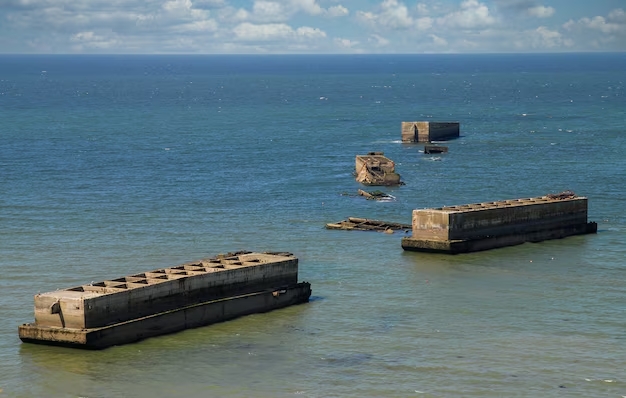Gold beach
Place aux britanniques
Gold Beach, located on the Normandy coast in the department of Calvados, is one of the five emblematic beaches of the Allied landings of June 6, 1944, a decisive moment in the Second World War. Assigned to British forces, notably the 50th Infantry Division (Northumbrian) and the 8th Armoured Brigade, Gold Beach was the scene of crucial operations that greatly contributed to the liberation of France and Western Europe from German occupation.
History of Gold Beach

On the morning of D-Day, British troops landed at Gold Beach, located between the communes of La Rivière-Saint-Sauveur and Port-en-Bessin, with the mission of securing the beach, penetrating inland to join American forces at Omaha Beach, and capturing the strategic town of Bayeux. Despite strong German resistance and well-prepared coastal defenses, the British soldiers, supported by engineers and special tanks known as “Hobart’s Funnies”, succeeded in establishing a bridgehead and advancing according to their objectives.
But Gold Beach is more than just its historic role during the D-Day; it also embodies a captivating blend of history, culture and natural landscapes that continue to enrich the visitor experience. Exploring Gold Beach and its surroundings offers a dive into a tumultuous past, while revealing the beauty and resilience of Normandy.
Beyond its 20th-century history, the area around Gold Beach is rich in Normandy heritage. Medieval castles, Romanesque churches and typical local markets offer a glimpse of life in Normandy through the centuries. The natural beauty of the area, with its cliffs, sandy beaches and lush green fields, invites outdoor activities such as hiking, cycling and sailing.
Strategy and challenges
On the morning of June 6, 1944, British forces approached Gold Beach with clear but challenging objectives. Their mission was to seize German batteries capable of threatening the Allied landings, establish a strong bridgehead for future operations, and capture the vital town of Bayeux and the strategic port of Caen. Despite strong resistance and formidable obstacles, the ingenuity and courage of the troops enabled a significant advance to be made on the very first day.
The success of the Gold Beach landing was due to a combination of meticulous planning, the bravery of the troops in combat, and the use of innovative equipment. Hobart’s Funnies”, tanks designed specifically for landing operations, such as the amphibious Duplex Drive (DD) and Crab flail tanks, played a vital role in clearing the beaches of obstacles and mines.
The technical and logistical challenges encountered at Gold Beach stimulated some remarkable innovations. Mulberry Harbour, a temporary but massive structure built to facilitate the rapid unloading of military supplies, is one of the most notable engineering feats. In Arromanches, visitors can still observe the remains of this port, which bear witness to human ingenuity in the face of adversity.
Points of Interest and Trivia
- Arromanches-les-Bains: Located in the heart of the D-Day landing beaches, Arromanches is famous for the remains of the Mulberry artificial harbor, built by the Allies for the D-Day landings.
- Port-en-Bessin: This charming fishing port, located between Omaha and Gold Beach, has remained authentic and picturesque.
- Hobart’s Funnies in action: Specially modified tanks, known as “Hobart’s Funnies”, played a key role at Gold Beach, including a flail tank nicknamed “Double Trouble” that cleared a safe path through German defenses, demonstrating the crucial importance of technical innovation to the success of Allied operations.
- 50th Infantry Division Memorial: Located near Arromanches, this memorial pays tribute to the soldiers of the 50th Division who landed on Gold Beach and fought bravely for the liberation of Normandy.
- “Sergeant Stubby” and the War Dogs: Although “Sergeant Stubby” is famous for his exploits in World War I, his story is a reminder of the vital role of courageous animals during conflict, including at Gold Beach, where dogs supported Allied troops with reconnaissance and comfort.
Continuous Impact
The story of Gold Beach continues to inspire films, documentaries, books and artistic works, underscoring the lasting impact of these events on popular culture and the collective consciousness. Schools, historians and families come from far and wide to learn, remember and pass on the lessons learned from the sacrifices of those who fought for freedom.
Gold Beach is dotted with monuments and memorials dedicated to the military units and individual soldiers who took part in the operation. These sites of remembrance, such as the 50th Infantry Division (Northumbrian) Memorial, provide spaces for reflection on the human cost of war and the value of peace.
Why visit Gold Beach?
To visit Gold Beach is to embark on a journey through time, where every monument, museum and beach tells a story of bravery, strategy and hope. It’s also an opportunity to connect with Normandy’s magnificent nature and rich cultural heritage, making every visit a memorable and enriching experience.
Ultimately, Gold Beach is more than just a page in the history of the Second World War; it represents a living chapter in our shared past, a place where history continues to influence the present and inspire the future. Whether through education, remembrance or the simple appreciation of natural beauty, Gold Beach remains an eternal testament to what humanity can achieve when united in a just cause.
Visiting Gold Beach is not only an act of remembrance; it’s also an opportunity to discover the natural beauty of the Normandy coast, rich in history and culture. It’s an educational and emotional experience, allowing us to understand the sacrifices of those who fought for freedom and peace.
The preservation of Gold Beach and the D-Day sites reminds us of the importance of remembering the lessons of the past, while celebrating the values of courage, determination and solidarity that continue to inspire future generations.
